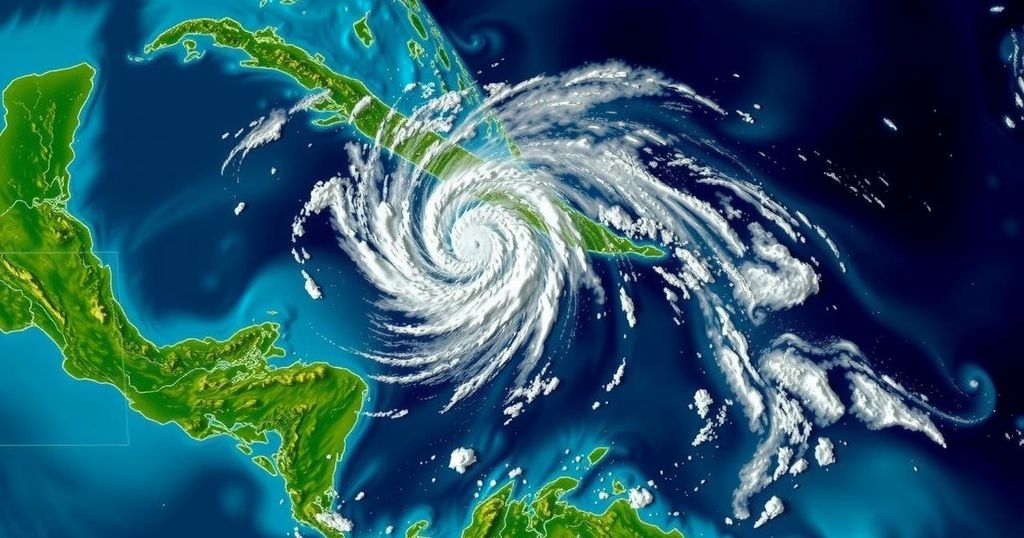Tropical Storm Sara Threatens Honduras Amid an Active Hurricane Season

Tropical Storm Sara has formed in the Western Caribbean, initially moving towards northwest Honduras with sustained winds of 40 mph. It is expected to bring catastrophic rainfall of up to 20 inches, leading to flash floods and mudslides. This season has seen an uptick in hurricane activity, and Honduras is still recovering from past hurricanes which inflicted dire consequences on the nation.
Tropical Storm Sara formed in the Western Caribbean on November 14, 2024, shortly after Tropical Depression 19 emerged in near-record warm waters. By early afternoon, the storm’s sustained winds reached 40 mph. It is projected to trigger extreme rainfall, potentially causing significant flooding throughout northern Honduras, with up to 20 inches of rain expected. As of Thursday, heavy rainfall has already begun in northeastern Honduras, with the town of Trujillo experiencing over 3.5 inches within 30 hours. While the larger forecast indicates Sara may bring heavy rain to parts of Florida later next week, its initial westward trajectory creates an adverse risk for Honduras, where previous storms have caused devastating impacts. The current Atlantic hurricane season has been notably hyperactive, characterized by 18 named storms, 11 hurricanes, and 5 major hurricanes, surpassing average seasonal metrics. Remarkably, this is the first occurrence of the name “Sara” in the Atlantic hurricane list, following its addition after Hurricane Sandy’s devastation in 2012. The storm is anticipated to maintain a slow westward pace, impacting the Honduran landscape significantly while possibly diminishing its strength over time as it interacts with the rugged terrain. Though forecasts suggest that Sara may evolve into a weaker storm as it traverses the Yucatan Peninsula into the Gulf of Mexico, the upcoming rains pose a serious threat to Honduras’ already precarious situation. Honduras continues to grapple with the aftermath of severe weather events over the last two decades, notably Hurricane Mitch in 1998 and the more recent Hurricanes Eta and Iota in 2020. These hurricanes collectively inflicted significant suffering, including fatalities and extensive economic losses, leading to increased migration to the U.S. due to environmental disturbances. Reports indicate that in 2021, 46% of migrants cited environmental factors, such as hurricanes and droughts, as contributing reasons for their displacement. The looming threat of Tropical Storm Sara raises alarm bells, as it could exacerbate the already dire situation in a nation that has yet to fully recover from past hurricanes and their cascading effects.
The origin of Tropical Storm Sara is situated in the context of an exceedingly active hurricane season for the Atlantic in 2024. Emerging from almost record-high ocean temperatures, this storm comes with the accumulated cyclone energy (ACE) index rising above average levels, qualifying this season as hyperactive. Historically, late-season storms like Sara have severe implications for regions like Honduras, which bear memories of catastrophic impacts from past hurricanes. With ongoing environmental issues and vulnerabilities, Honduras faces the dual challenge of preparing for potential disasters while recovering from prior ones that have left significant scars on its population and economy.
In conclusion, Tropical Storm Sara poses significant risks to Honduras, where previous hurricanes have caused extensive damage and loss of life. This storm adds to a hyperactive hurricane season, raising concerns for anticipated extreme rainfall and flooding. Honduras’ history with devastating storms underlines the urgency for effective disaster preparedness and climate response. The potential aftermath of Sara could further strain an already vulnerable society, emphasizing the importance of awareness and proactive measures against climate-related disasters.
Original Source: yaleclimateconnections.org






